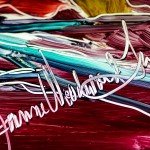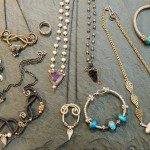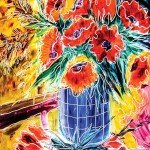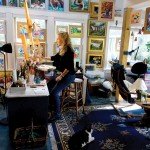+ By Sydney Petty + Photos by Alison Harbaugh
Once you learn that Joanne Woodward Tew is from Maine, it explains a lot about her artistic career. Her jewelry pieces, for example, are beautiful, excellently crafted renditions of artistic whimsy. Her free-flowing, asymmetrical designs incorporate elements of art nouveau style, Victorian filigree, and shells, stones, and other natural artifacts. Each is infused with Tew’s characteristic dry, “wicked” Maine wit.
 Tew has pursued many artistic mediums, including oil painting, woodworking (she made her first child’s crib), sewing (she made her children’s clothes and husband’s shirts and jackets when the family moved to Baltimore for his career) and her latest passion, oil-on-glass paintings that incorporate watercolor and oil techniques. The paintings are designed for display on windows, where they present differently under varying lighting conditions.
Tew has pursued many artistic mediums, including oil painting, woodworking (she made her first child’s crib), sewing (she made her children’s clothes and husband’s shirts and jackets when the family moved to Baltimore for his career) and her latest passion, oil-on-glass paintings that incorporate watercolor and oil techniques. The paintings are designed for display on windows, where they present differently under varying lighting conditions.
Surprisingly, jewelry-making became Tew’s financial mainstay through her years of transition following a divorce. “It is very hard to help support a family as an artist,” she says, “but I had three young kids and couldn’t afford daycare, so I had to come up with a living.”
People from Maine are known as rugged, hard-working people, and Tew embodies that Yankee temperament. Her family’s Maine roots harken back to the 1700s, when her French great-grandfather fled persecution by the Huguenots and settled in Dresden, a small southern town on the Kennebec River. Her family still owns farmland there.
“I never wanted to be anything but an artist,” she says. Artistic aptitude runs in the family. Her grandfather was an artisan woodworker who built houses, furniture, and violins and painted. Her father, whose wooden sculptures stud her studio, encouraged her talents.
 “Dad made a living as an architect,” she recalls, “but his real passion was sculpting. I used to walk out to his workshop at the back of our property, where he would be carving huge sculptures made from the trunks of trees.”
“Dad made a living as an architect,” she recalls, “but his real passion was sculpting. I used to walk out to his workshop at the back of our property, where he would be carving huge sculptures made from the trunks of trees.”
Her father shared his love of nature with Tew and her brother. They spent countless hours hiking through the woods, and skiing every winter weekend. He also taught them to care for their family farm.
When Tew was 15 years old, her father sculpted a bust of her head. “I had to sit and model for him for hours,” she says. They discussed his work and her interest in painting and drawing. “There were no art classes at our school, so he and my mother got me private art lessons.”
In 1989, needing money to raise her children, Tew tried selling her pottery at a juried show. But the real sellers that day were some of her porcelain jewelry pieces that she had brought along, so she decided to change focus. “I wasn’t going to schlep all those pots around when the jewelry made more,” she says.
She made her jewelry with colored clay, using a technique called millefiori—the clay is layered into loaves and sliced into small flat shapes to form the pieces, then glazed and fired in a kiln. She began adding metal elements to show movement and beads and stones to enhance the designs.
She studied metalsmithing at Towson University and Maryland Institute College of Art. “I tried making chain for a while, but found it tedious,” she says. “Since I am not a precise or highly meticulous person, I found forging [hammered work], fabrication, and wirework to play more of a role in my process.”
 Over time, and given the need to create inventory, she developed pieces reflecting her style that could be made fairly quickly. She also worked on more intricate pieces, often incorporating differently forged shapes with fabricated silver, gold leaves, and bezel-set stones.
Over time, and given the need to create inventory, she developed pieces reflecting her style that could be made fairly quickly. She also worked on more intricate pieces, often incorporating differently forged shapes with fabricated silver, gold leaves, and bezel-set stones.
Her driving force? “Fear!” she exclaims. “If I had stayed married, I probably would not have become a successful jeweler. My initial success with it drove me to become more creative with the jewelry and more prolific. I didn’t want to become a production jeweler—I like making one-of-a-kind pieces.” Every day, after her children left the house, she worked in her studio. “I owe my success to being on a daily work schedule and to attending so many juried shows a year.”
Tew made her jewelry enterprise a ringing success that helped pay bills and see her through challenging times. Today, her children are grown and she lives in Eastport. Her home is decorated with her own and other artists’ works, many of which were bartered at art shows. In her spacious studio, which occupies part of the backyard, she focuses on painting. She also teaches art at the Ginger Cove retirement community.
She maintains her passion for the outdoors. “It was the sailing culture that brought me to Eastport from Baltimore,” she says. She returns to Maine frequently for visits to the family farm and the seashore, where she finds much artistic inspiration. Like the Maine weather, Tew’s art has changed and shifted. She has followed it along various paths to earn a living and build the only life she’s wanted—that of an artist. █



















